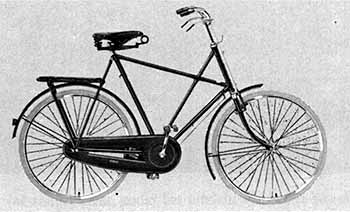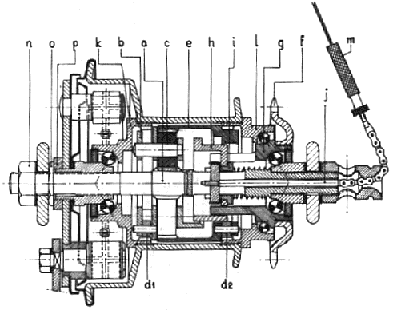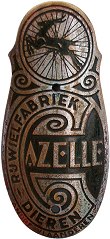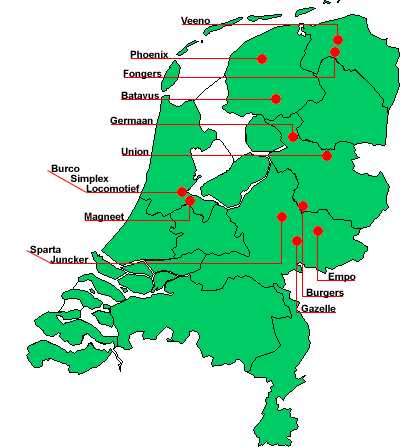1892: Willem Kölling, working as a
post office agent in the Dutch village of Dieren, resigns and starts a bicycle trade by
ordering one bike in England. His trade expands prosperously. Kölling starts a
co-operation with the hardware and stove retailer Rudolf Arentzen from Dieren. 1902: Arentzen and Kölling buy new
premises at the site of the present factory, and start the production of bicycles. In the
same year, the first complete, Gazelle branded bicycle is sold.
1903: Gazelle introduces its
first motorbike, which however, was not made by Gazelle itself.
1905: Despite the prosperous
trade Arentzen withdraws himself from the company. His place is taken by Hendrik Kölling,
a brother of Willem Kölling.
1912: With a big expansion of
their original premises, and with the modern, specialised machinery, their own production
plans can be fully realised. They specialise in the fabrication of complete bicycles.
Meanwhile Gazelle's wholesales activity becomes increasingly important.
1915: The Köllings and their
nephew Jan Breuking rename the company to "N.V. Gazelle Rijwielfabriek v/h Arentzen
en Kölling".
In the next twenty-five years the
company grows steadily. The domestic outlet as well as the international demand increase
significantly. This is also due to the growing market for Gazelle bikes in Indonesia, at
that time a Dutch colony. Besides standard bicycles, several kinds of motorised bicycles,
delivery bicycles and carrier tricycles were produced for various sectors of industry.
1930 of 1931: Gazelle introduces
the cross frame models 9X and 8V.

Gazelle cross frame
1931: As a value variety the
brand Invicta appears in the Gazelle catalogue. Meanwhile the brand Gelria is introduced,
too.
1935: Gazelle introduces the
first tandem, which is extremely popular in the years before the second world war. In the
year of its introduction, 600 tandems are sold instantly.
1937: An electric bicycle
powered by a 12 V accumulator and designed by Philips, is taken in production with
five well-known Dutch bicycle makers. Amongst them, Gazelle is the most important one and
they produce 117 of these bicycles. However, they never become very popular.
Like for many other Dutch companies,
the war is a difficult period for Gazelle. Most of the plant equipment is being dismounted
by the German occupying forces and transported to Germany. The remaining machinery is
blown-up just before the arrival of the Allies. Furthermore, the factory of Willem
Kölling suffers severe damage from the war fighting.
In Augustus 1946 the first post-war
Gazelle bicycles are available, and in 1950 the first Gazelle with clip-on motor. The
production of carrier bicycles and tricycles is being continued.
1954: The former private company
Gazelle is turned into an incorporation. In the same year, Gazelle builds the 1,000,000
bicycle.
1963: In early 1963, Gazelle
mergers with Batavus from Heerenveen. This cooperation couldn't fulfill the underlying
expectations and was broken-up after two years.
1964: Gazelle is the first Dutch
bicycle manufacturer to introduce a folding bike named the "Kwikstep". In
contrary to virtually any other common folding bike construction, the Kwikstep is folded
around a horizontal axis under the bottom bracket instead of a vertical axis.
1966: Gazelle reintroduces a
tandem model, this time in a modern, less heavy version. In the same year the 2,000,000
Gazelle bicycle is built.
 1968: Gazelle takes over the Juncker, Simplex and
Locomotief brands as well as the well-known moped brand Berini. 1968: Gazelle takes over the Juncker, Simplex and
Locomotief brands as well as the well-known moped brand Berini.
In addition to the Gazelle branded
drum-brake front hub, which is still in production today, Gazelle also builds a
three-speed rear hub without and (in most cases) with drum brake in the sixties. After
having built some 45.000 - 50.000 units, the production is ceased by the end of the
sixties because of the high costs.
1971: Gazelle is taken-over by
Tube lnvestment (TI). The name of the firm is now "Gazelle Rijwielfabriek B.V.",
a private limited company.
1987: TI sells its bicycle
division to Derby Cycles Corp. This multinational corporation with headquarters in New
York nowadays also owns bicycle manufacturer Raleigh, cycle hub producer Sturmey-Archer as
well as the well-known German bicycle brands Kalkhoff, Rixe, Winora and Staiger.
1992: Gazelle celebrates the 100
years anniversary. In the same year, the cumulative total production reaches 8 million
units.
1999: In april, Gazelle reaches
a new milestone: the 10 millionth bicycle leaves the factory. The Gazelle works now employ
550 people and produce over 300.000 bicycles a year. Gazelle is one of the few bicycle
manufacturers of this size which still build most of the frames themselves. 20 % of
the total production is exported to Belgium and the neighbouring regions of Germany.
2001: Derby Cycles Corporation
sells Gazelle to the Dutch investment funds 'Gilde Buy Out Fund'. Gazelle does very well,
but Derby is in big financial troubles. The annual production is about 380.000 units,
while Gazelle's market share amounts to some thirty percent.
Today, Gazelle is still the figurehead
of the Dutch bicycle industry. Gazelle bicycles have been built in large numbers and are
known to be very sound and comfortable - the Mercedes Benz of the Dutch bicycle brands.

Foldable Gazelle carrier
(first built in 1930) with foldable carrying box and convertable the chassis;
and modern Gazelle Cabby (2008) with foldable and detachable box for
children transport.
|


 1968: Gazelle takes over the Juncker, Simplex and
Locomotief brands as well as the well-known moped brand Berini.
1968: Gazelle takes over the Juncker, Simplex and
Locomotief brands as well as the well-known moped brand Berini.

